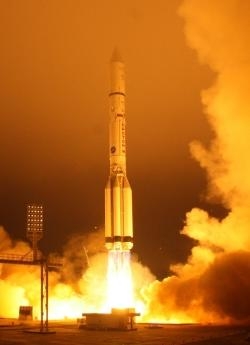Tue, Dec 10, 2013
First Global XpressA Satellite Launch; 7th ILS Proton Launch Of 2013
An International Launch Services (ILS) Proton Breeze M successfully placed the Inmarsat-5 F1 (I-5 F1) satellite into a super-synchronous (geo-stationary) transfer orbit (SSTO) Sunday. The spacecraft was launched for Inmarsat. I-5 F1 is the first of three Inmarsat next-generation Global Xpress satellites scheduled to launch before the end of 2014. This marks the seventh launch of the year and the third SSTO mission for ILS, a leader in providing mission integration and launch services to the global commercial satellite industry.

The Proton launch vehicle, carrying the I-5 F1 satellite, lifted off from Pad 39 at the Baikonur Cosmodrome Sunday at 1812 local time (1212 GMT). The SSTO mission utilized a 5-burn Breeze M mission design to advance the orbital unit first to a circular parking orbit, then to an intermediate orbit, followed by a transfer orbit, and finally to a 65,000 km-apogee super-synchronous transfer orbit. After a 15-hour, 31-minute mission, the satellite was placed into the target orbit by the Proton launcher. SSTO missions provide increased heavy-lift performance over GTO mission designs, allowing our customers the capability to maximize spacecraft operational lifetime.
The satellite was manufactured by Boeing Satellite Systems International and built on the 702HP platform. Weighing over 6 metric tons at lift-off, the I-5 F1 satellite has 89 Ka-band fixed beams and 6 steerable ones. I-5 F1 is designed to generate approximately 15 kilowatts of power at the start of service and approximately 13.8 kilowatts at the end of its 15-year design life. To generate such high power, the spacecraft's two solar wings employ five panels of ultra-triple-junction solar cells.
Global Xpress will be the first globally available high-speed broadband Ka-band network. It will offer the unique combination of global coverage from a single operator, consistent higher performance of up to 50Mbps, and the network reliability for which Inmarsat is renowned. Based on Ka-band technology, Global Xpress will consistently deliver higher performance through more compact terminals at a lower cost than existing VSAT services, making it accessible to many more users.
ILS President Phil Slack stated, “We are honored to share this momentous occasion with Inmarsat, true innovators in the satellite communications industry, with the first ILS Proton launch of three in the Global Xpress constellation. Today’s ILS Proton launch builds on a strong relationship between Inmarsat and ILS dating back to 2008 with the launch of an Inmarsat-4 satellite. We thank the teams who worked tirelessly on the successful launch of I-5 F1 and look forward to our upcoming missions with Inmarsat.”
“Global Xpress is the result of three years of planning and, together with a fourth Inmarsat-5 satellite we ordered recently from Boeing, represents an investment of $1.6 billion in our next generation of high bandwidth, high capacity, mobile broadband communications satellites,” said Rupert Pearce, CEO, Inmarsat. “Our Global Xpress constellation, which is on schedule to achieve full global coverage by the end of 2014, will ensure our satellite services fully support the current and future needs of our end-users across the world - whether on land, at sea or in the air. I wish to thank the teams at Inmarsat and Boeing for their hard work and ingenuity in bringing this highly innovative program to fruition. We also thank our experienced partners at ILS and Khrunichev for their dedication and assurance in ensuring this mission was successful. We look forward to our future ILS Proton launches next year.”
The I-5 F1 launch also marked the 392nd launch for Proton since its maiden flight in 1965 and the 84th ILS Proton Launch overall. This was also the 16th Boeing-built satellite launched on an ILS Proton and the 3rd Inmarsat satellite launched on Proton overall. The Proton M Breeze M vehicle is developed and built by Khrunichev Research and Production Space Center of Moscow, Russia’s premier space industry manufacturer and majority shareholder in ILS.
(Image provided by ILS)
More News
Aviation Governance Secured...At Least For a While The National Business Aviation Association similarly applauded the passage of the FAA's recent reauthorization, contentedly recou>[...]
Emphasis On Growing The Future of Aviation Through Concentration on 'AFFORDABLE FLYERS' It's been a number of years since the Latest Edition of Jim Campbell's HUGE SportPlane Resou>[...]
Amazilia Aerospace GmbH, Develops Digital Flight Control, Flight Guidance And Vehicle Management Systems Textron eAviation has acquired substantially all the assets of Amazilia Aer>[...]
Honeywell's Primus Brings New Tools and Niceties for Hawker Operators Hawker 4000 business jet operators have a new installation on the table, now that the FAA has granted an STC f>[...]
Company Celebrates Niche-but-Important Advancement in Industry Standards Echodyne has announced full integration of its proprietary 'EchoFlight' radar into the e American Aerospace>[...]
 Bolen Gives Congress a Rare Thumbs-Up
Bolen Gives Congress a Rare Thumbs-Up The SportPlane Resource Guide RETURNS!!!!
The SportPlane Resource Guide RETURNS!!!! Buying Sprees Continue: Textron eAviation Takes On Amazilia Aerospace
Buying Sprees Continue: Textron eAviation Takes On Amazilia Aerospace Hawker 4000 Bizjets Gain Nav System, Data Link STC
Hawker 4000 Bizjets Gain Nav System, Data Link STC Echodyne Gets BVLOS Waiver for AiRanger Aircraft
Echodyne Gets BVLOS Waiver for AiRanger Aircraft



